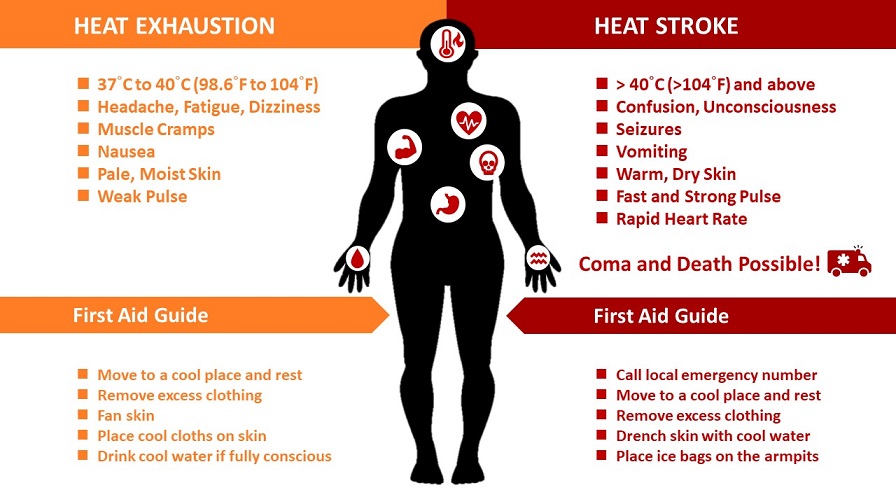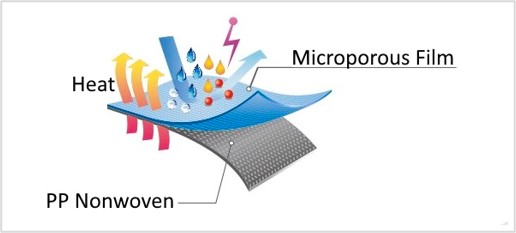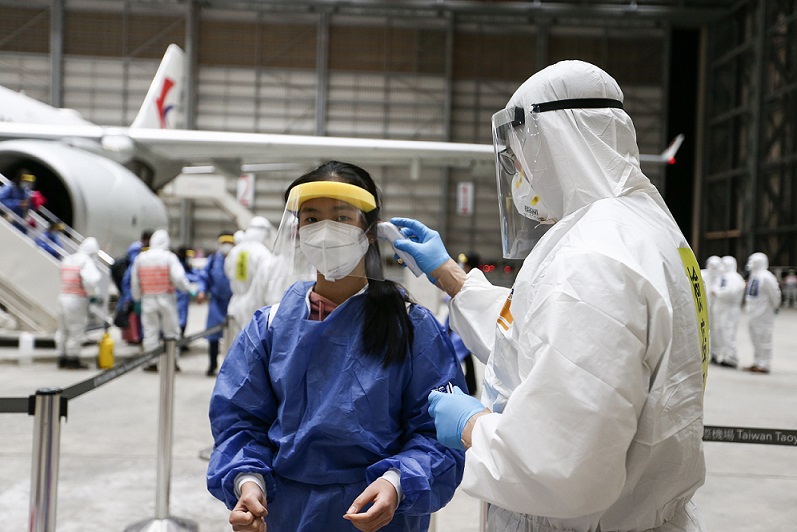2020 is on track to be one of record-breaking hottest years. When the body could not cool itself enough to maintain a safe temperature, heat stress is often a major healthcare problem. Therefore, frontline operators should be given extra care as they must wear full Personal Protective Equipment (PPE) during COVID-19 infection control.
Heat stress can cause heat exhaustion and lead to heat stroke if the body core temperature is unable to cool down. The major symptoms of two conditions are different, hence the first aid guide also varies based on each situation. Please be aware that heatstroke is the most severe form of heat illness, it is a life-threatening emergency and requires immediate medical attention.
 Figure 1. Comparison of Heat Exhaustion & Heat Stroke
Figure 1. Comparison of Heat Exhaustion & Heat Stroke
Wearing PPE increases heat stress, but other conditions also impose an increased risk of heat-related illness on medical personnel. These include working in hot ambulatory care services, working long shifts with short breaks, and having limited opportunity to consume liquids to remain hydrated.
Prevent Heat Stress Under COVID-19 for Frontline Operator
Due to COVID-19 disease control, some frontline operators need to wear additional PPE more than usual in their workplace. This can contribute to difficulties in dissipating heat from the body and causing heat illness. There are however five ways to reduce heat stress risks and stay healthy from COVID-19 when wearing full PPE:
Start Cool Before Working
Frontline operators are encouraged to hydrate with cold beverages or ice slurry before putting on your PPE. Precooling helps lower the core temperature of your starting body and become acclimatized to the heat.
Reduce Rises in Body Core Temperature by Appropriate Coverall
As protective clothing covers most body parts during the infection control process, this makes it difficult to lose body heat as sweats cannot evaporate easily. You can select breathable protective clothing by focusing on the Moisture Vapor Transmission Rate (MVTR), Resistance to Evaporating Heat Transfer (Ret), and breathability of the fabric. You can also reduce layers of clothing underneath and be effective in your movements to minimize an excessive increase in body heat.
- Moisture Vapor Transmission Rate (MVTR)
It can be referred to the speed at which sweat dissipates from the skin and achieve the desired effect of “moisture-wicking”. It can be an indicator of how comfortable a coverall is for its wearer.
- Resistance to Evaporating Heat Transfer (Ret)
It determines the resistance that a material has to water vapor. In contrast to the MVTR, the lower the Ret value is the less resistance to moisture transfer and therefore higher breathability.

Figure 2. ULTITEC Fabric Construction
Encourage Work/Rest Schedules and Stay Hydrated
We should set up a ventilated rest area and provide them with regular and longer breaks. It will effectively allow body heat to dissipate. Prepare clean and cool drinking water in the rest area to remain hydrated, as the body consists of around 60% water.
Social Distancing
One of the most effective methods for limiting the spread of COVID-19 is to keep a certain distance. For example, keep physical distance between each other within the rest area. Each rest area should also limit the number of individuals, in line with the local guidelines on gathering capacity.
Prevention Supplies
Provide sufficient COVID-19 prevention supplies onsite namely soap, alcohol-based hand sanitizers (at least 60% alcohol), tissues, and trash baskets. If possible, daily PPE replacement is better at remaining safe in the workplace.

Figure 3. ULTITEC Being Applied for COVID-19 Disease Control
Conclusion
Although precautions for heat stress are simple but often overlooked. This information series aims to highlight some issues and options to take into consideration when managing the health risks of extreme heat during the COVID-19 pandemic. It is necessary to ensure that frontline operators are protected from both infection and heat stress so that they can continue to perform their duties effectively throughout the crisis.

